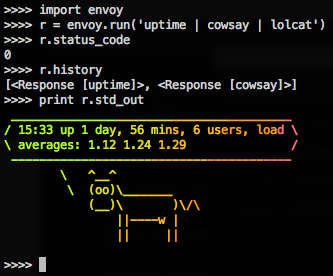envoy
envoy 库的介绍上说它是一个可以被人类理解的 python 子进程。可以看出这个库的主要做用是使得 python 子进程的使用更加便利高效,并且符合人类的使用习惯。
前置知识点
看源码前需要对下面几个 python 原生库的使用有了解:
shlexsubprocess.Popenthreading.Thread
可以参考本文最后的参考资料。我也是边看源码边看查阅资料 🙂 ,感觉这样比较高效
使用

源码
envoy 首先使用 shlex 对输入的命令行字符串进行解析:
1
2
3
4
5
6
7
8
9
10
11
12
13
14
15
16
17
18
19
20
| def expand_args(command):
"""Parses command strings and returns a Popen-ready list."""
if isinstance(command, (str, unicode)):
splitter = shlex.shlex(command.encode('utf-8'))
splitter.whitespace = '|'
splitter.whitespace_split = True
command = []
while True:
token = splitter.get_token()
if token:
command.append(token)
else:
break
command = list(map(shlex.split, command))
return command
|
如果对 shlex 原生库的使用比较熟悉的(我也不熟悉),这个函数就很容易理解。
举个例子:当函数接受的参数是 ls -l | grep py 时, 函数的 while循环首先会将输入解析为数组 ['ls -l', 'grep py'],然后再使用 shlex.split 进一步解析为二维数组 [['ls', '-l'], ['grep', 'py']]。
这里解析为二维数组是因为后面的 subprocess.Popen 方法的第一个参数是字符串列表。subprocess.Popen 的使用参考本文最后的参考文章。
然后是构建子进程和传递 stdin 和 stdout 的过程, 具体的解析我在代码里做了注释:
1
2
3
4
5
6
7
8
9
10
11
12
13
14
15
16
17
18
19
20
21
22
23
24
25
26
27
28
29
30
31
32
33
34
35
36
37
38
39
40
41
42
43
44
45
46
47
48
49
50
51
52
53
54
55
56
| def run(self, data, timeout, kill_timeout, env, cwd):
self.data = data
environ = dict(os.environ)
environ.update(env or {})
def target():
try:
'''
执行子进程
这里的 self.cmd 就是上面 shlex 处理后返回的字符串列表
注意接受字符串列表时 shell=False
要给子进程的stdin发送数据,则Popen的时候,stdin要为PIPE;
同理,要可以发送数据的话,stdout或者stderr也要为PIPE
'''
self.process = subprocess.Popen(self.cmd,
universal_newlines=True,
shell=False,
env=environ,
stdin=subprocess.PIPE,
stdout=subprocess.PIPE,
stderr=subprocess.PIPE,
bufsize=0,
cwd=cwd,
)
if sys.version_info[0] >= 3:
'''
和子进程交互:
将上一个子进程的 stdout 数据 PIPE 到这个子进程的 stdin
并从stdout和stderr读数据,直到收到EOF
'''
self.out, self.err = self.process.communicate(
input = bytes(self.data, "UTF-8") if self.data else None
)
else:
self.out, self.err = self.process.communicate(self.data)
except Exception as exc:
self.exc = exc
thread = threading.Thread(target=target)
thread.start()
thread.join(timeout)
if self.exc:
raise self.exc
if _is_alive(thread) :
_terminate_process(self.process)
thread.join(kill_timeout)
if _is_alive(thread):
_kill_process(self.process)
thread.join()
self.returncode = self.process.returncode
return self.out, self.err
|
另外,对于 Popen 的使用,下面是一个简单的例子:

参考资料
python 中的 subprocess.Popen()使用
Python 多线程编程(一):threading 模块 Thread 类的用法详解

